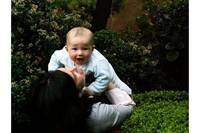
08 Feb Toddlers Who Lack Attention to Mother’s Speech More Likely to Be Diagnosed with Autism
MedicalResearch.com Interview with:

Dr. Pierce
Karen Pierce, Ph.D.
Professor, Department of Neurosciences, UCSD
Co-Director, Autism Center of Excellence, UCSD
MedicalResearch.com: What is the background for this study?
Response: The mean age of ASD diagnosis and eventual treatment remains at ~52 months in the United States1 – years beyond the disorder’s prenatal origins2, and beyond the age when it can be reliably diagnosed in many cases3.
Currently the only way to determine if a child has autism spectrum disorder (ASD) is to receive a developmental evaluation from an experienced clinician (usually a licensed clinical psychologist). There are often long waiting lists, and only a small number of clinicians have the experience required to make early-age (i.e., between 12-36 months) diagnoses of ASD. Thus, there are many places in the country as well as world wide wherein children wait months or years to receive a formal diagnosis due to a lack of available expertise. Moreover, diagnostic evaluations are expensive and usually cost the parent and/or insurance approximately ~$2,000 or more per evaluation. Finally, clinical evaluations usually take between 2-3 hours to complete and result in fatigue for both the parent and toddler.
Eye-tracking, which generates biologically-relevant, objective, and quantifiable metrics of both visual and auditory preference profiles in babies and toddlers in just minutes, is a technology that can dramatically change how ASD is diagnosed.
MedicalResearch.com: What are the main findings?
 Response: A brief summary of the findings of our study is as follow: almost all of the toddlers who participated in an eye tracking study who showed low levels of attention to motherese speech received a diagnosis of autism from a clinical psychologist who was blind to their eye tracking results. This is a notable finding because each eye tracking test can be completed in about a minute.
Response: A brief summary of the findings of our study is as follow: almost all of the toddlers who participated in an eye tracking study who showed low levels of attention to motherese speech received a diagnosis of autism from a clinical psychologist who was blind to their eye tracking results. This is a notable finding because each eye tracking test can be completed in about a minute.
A more detailed and comprehensive summary of our study is as follows: 653 toddlers aged 1 to 3 years old participated in an eye tracking study. Toddlers were presented with two videos on a screen: one of a woman speaking in motherese, and one non-human scene (either a busy highway or a movie of abstract shapes and numbers with accompanying electronic music). The videos were available for one minute, and the toddlers used their eyes to control which video played at a given time.
If any given toddler looked at the actress speaking in motherese less than 30% of the time, the probability that they would receive a diagnosis of autism from a licensed clinical psychologist blind to their eye tracking score was 94%.
Findings also showed that the toddlers that attended to motherese speech less than 30% of the time also had more challenges with speaking, cognition and social behavior, pointing to the importance of attending to human speech during early development.
It is important to note that only about a third of children who received a diagnosis of autism ‘failed’ the motherese eye tracking test, highlighting that eye tracking can detect a special subtype of ASD. In this case, the subtype are children who shy away from attending to speech.
This is one of the only studies to use ‘gaze contingent’ eye tracking technology which allows the toddler to control what movie they saw, giving us great insight into what interests them.
Finally, it is important to note that there were many toddlers who received a diagnosis of autism from a psychologist who ‘passed’ the motherese eye tracking test. These toddlers tended to have better language and social behavior and highlights the fact that eye tracking can shed light on a both a toddlers strengths as well as their weaknesses and may be a particularly powerful tool for predicting a child’s clinical course.
MedicalResearch.com: What should readers take away from your report?
There are 2 key take aways from this research:
- If a toddler between 12-48 months doesn’t appear to pay attention to parents while they are speaking to him/her, this could be an early warning sign of autism and warrants a follow up with a qualified professional.
- Autism can be accurately diagnosed in a subset of children using new eye tracking technology in just a few minutes. This finding helps us to re-think how autism is diagnosed, and opens up unprecedented opportunity to access diagnoses in remote areas where there are no clinicians available and to fast track participation in autism-relevant treatment.
MedicalResearch.com: What recommendations do you have for future research as a results of this study?
Response: Future research should push the boundaries of what eye tracking technology can do to help children with autism and families. For example, scientists could possibly test whether or not treatment recommendations based on a child’s eye gaze profile accelerates gains in treatment faster than standard of care treatment.
Disclosures: All of the research reported in the study was funded by the National Institute of Mental Health. Dr. Pierce has a patent pending through the University of California, San Diego that incorporates the eye tracking tests. Dr. Pierce received a donation from the ACES Innovation Fund to examine new ways to leverage eye tracking technology that could benefit children and families.
Citations:
- Maenner MJ, Shaw KA, Bakian AV, et al. Prevalence and Characteristics of Autism Spectrum Disorder Among Children Aged 8 Years – Autism and Developmental Disabilities Monitoring Network, 11 Sites, United States, 2018. MMWR Surveill Summ. Dec 3 2021;70(11):1-16. doi:10.15585/mmwr.ss7011a1
- Courchesne E, Gazestani VH, Lewis NE. Prenatal Origins of ASD: The When, What, and How of ASD Development. Trends in neurosciences. 2020;43(5):326-342. doi:10.1016/j.tins.2020.03.005
- Pierce K, Gazestani VH, Bacon E, et al. Evaluation of the Diagnostic Stability of the Early Autism Spectrum Disorder Phenotype in the General Population Starting at 12 Months. JAMA Pediatr. Jun 1 2019;173(6):578-587. doi:10.1001/jamapediatrics.2019.0624
- Pierce K, Wen TH, Zahiri J, et al. Level of Attention to Motherese Speech as an Early Marker of Autism Spectrum Disorder. JAMA Netw Open. 2023;6(2):e2255125. doi:10.1001/jamanetworkopen.2022.55125
The information on MedicalResearch.com is provided for educational purposes only, and is in no way intended to diagnose, cure, or treat any medical or other condition. Always seek the advice of your physician or other qualified health and ask your doctor any questions you may have regarding a medical condition. In addition to all other limitations and disclaimers in this agreement, service provider and its third party providers disclaim any liability or loss in connection with the content provided on this website.
Last Updated on February 8, 2023 by Marie Benz MD FAAD
